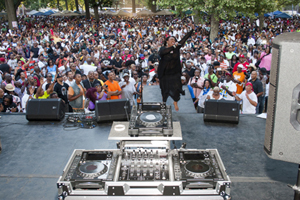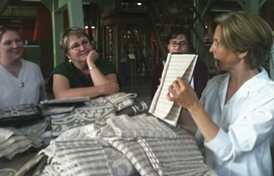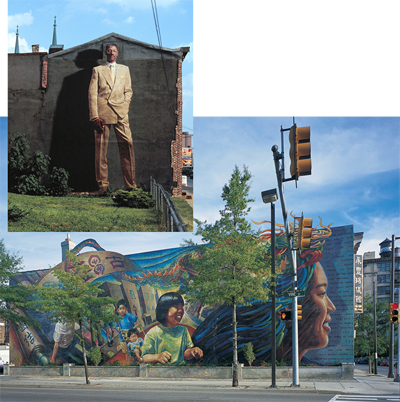On July 24, R&B artist Luke James launched Newark, New Jersey’s ninth annual Lincoln Park music festival to a packed, enthusiastic crowd. His revival and reinterpretation of R&B traditions is credited with helping bring the musical genre to a new generation. In much the same way, the festival itself is reawakening deep musical traditions. The 11-block Lincoln Park area was home to numerous jazz clubs in the 1930s through 1950s. Legendary Savoy Records was located there.

Tony Graves
Teresa Griffin, a vocalist from Chicago, performs at the 2013
Lincoln Park Music Festival, Newark, N.J.James’s opener was followed by jazz, gospel, house and hip-hop performers along with food and craft vendors, family games, health screenings and more. Despite the heat and occasional bursts of storm, tens of thousands of people participated.
But the festival’s impact extends well beyond a successful four-day event. It is part of a year-round focus on reviving Lincoln Park that includes providing green jobs training, operating a community farm, building affordable housing for residents and artists, and creating a performance space incorporating the façade of a historic church.
“The festival has made Lincoln Park a destination and helped tell the story of who Newark really is,” said Anthony Smith, interim executive director for Lincoln Park Coast Cultural District. “It is at the heart of our efforts to make Lincoln Park a safe, green and culturally rich community.”
Other cities and towns have realized similar success in leveraging the arts for community benefit. Asheville, North Carolina, and surrounding rural towns have capitalized on the Appalachian traditions of handcrafted furniture, textiles, basketry and other items as a draw for tourism and economic development. Buffalo, New York, has transformed a long-vacant auto plant into artist studios and housing, jump-starting renewal of a neighborhood in the city’s aging downtown.

Handmade in America
Textile fiber artists and entrepreneurs, working with the
non-profit group Handmade in America, tour the Oriole
custom weaving mill in Hendersonville, N.C.From main street parades and concerts in the park to the designation of arts districts and construction of museums designed by name architects, cities and towns across the country have looked to the arts to bolster civic pride, improve the quality of life for residents and create a climate for economic development.
But the kind of broad community engagement and support realized in Lincoln Park, Asheville and Buffalo can be elusive. That’s one reason that, over the past four years, a new movement called “creative placemaking” has begun drawing on insights from these and other successes to provide cities and towns a new model for harnessing the magic of the arts to build stronger communities.
Placemaking
As the name indicates, creative placemaking is an adaptation of the more general “placemaking” process and philosophy that has been widely adopted by urban planners. Placemaking entails a community-driven, bottom-up approach to creating well-designed neighborhoods, streets and public spaces that become valued destinations. Since its founding in 1975, the Project for Public Spaces has been the nation’s principal advocate for placemaking, a process it says “helps citizens transform their public spaces into vital places that highlight local assets, spur rejuvenation and serve common needs.”

Jack Ramsdale for the Mural Arts Program
The city’s Mural Arts program organized the creation of a portrait of 76ers great
Julius Erving in 1989 and “Gateway to Chinatown: Colors of Light” in 1999.Over the years, whether intentionally or not, many community arts projects have adopted the community engagement approaches of placemaking, often with great success. At a Creative Placemaking Leadership Summit hosted by Together North Jersey and the North Jersey Transportation Authority on June 19 in Newark, keynote speaker Jane Golden described her involvement with one such project in Philadelphia.
Beginning in 1984, she worked with art activists and community leaders to transform “a small, scrappy, grassroots” arts and anti- graffiti effort into a citywide public art program supported by the mayor. The Mural Arts Program she now heads creates murals and public art to support neighborhood renewal, engage residents and provide arts training to youth, prisoners and ex-offenders. It has become an international model.
“We’re providing public art to every community in the City of Philadelphia,” Golden said in an interview. “It enhances livability. It is a mirror that reflects back people’s aspirations, dreams, struggles, triumphs, histories and stories.”
The Creation of Arts Districts
Other community arts projects have varied greatly in their planning processes and level of community engagement, with predictably mixed results. Indeed some arts-based neighborhood renewal occurs entirely unplanned—notably when artists move into run-down neighborhoods on the fringes of cities in search of cheap studio space and housing. Often, gentrification soon follows and the artists are priced out of the very neighborhoods they revived. Artists are engaged in fights over gentrification in San Francisco’s Mission District, the Bushwick section of Brooklyn, the Peckham section of London and Hamburg, Germany, among other locations.
A more orderly approach to arts redevelopment pursued by many cities is the creation and nurturing of arts districts, whether developed from scratch or encompassing areas already attracting artists and arts-related businesses. More than 500 arts districts have been established across the country, but despite their popularity they face serious challenges.
“You see a lot of … districts eventually kind of peter out because they’re either not doing what they’re supposed to do or there is not enough support from the state or municipalities for them,” said Indiana University Assistant Professor Joanna Woronkowicz. In a forthcoming book, Woronkowicz and two co-authors report on a study of major cultural facilities built nationwide from 1994-2008. She noted that Indiana established a statewide program for cultural districts but provided no funding to towns.
Ample funding alone does not guarantee success. Many cities and towns, rather than spreading funding among diverse groups and projects and engaging the community, attempt to “go big” with multimillion dollar
investments in performing arts centers, museums, theaters or other facilities—often with eye-catching architecture—in a bold bid to draw crowds and spur further investment. A few succeed but the odds aren’t good.
“We didn’t see any positive or negative effects [of the facilities] on the surrounding region’s economy,” Woronkowicz said. “This runs counter to the common wisdom that these facilities are big money makers.”
New Concept
Bringing some order to the process of arts-based redevelopment across the country—and building upon the successes—was one of the first priorities of Rocco Landesman on his appointment as chairman of the National Endowment of the Arts in 2009. (He served one term, leaving in 2013.) Landesman, with a background as a longtime Broadway theater producer, changed the agency’s motto to “Art Works.”

Baltimore Office of Promotion & the Arts
Baltimore-based FORCE’s Monument Picnic in Penn Station plaza.As he explained in the Arts Reader in 2013, “Any plan that addresses economic growth and urban and neighborhood revitalization has to include the arts. We know and we can prove that when you bring arts and artists into the center of town, that town changes. … Artists are great placemakers.”
The NEA commissioned researchers Ann Markusen and Anne Gadwa to conduct a national survey of arts-based redevelopment projects to identify the common ingredients of success. Their 2010 paper pointed to the need for arts projects to adopt the placemaking techniques of engaging the community and forming partnerships among a wide range of local interests and leaders. The use of “creative placemaking” as the paper’s title launched the term into wide use.
To follow-up on the paper’s call for systematic efforts supporting the concept (and at the urging of Landesman), several private foundations joined together to found ArtPlace America, pooling their grant-making activities in support of placemaking arts projects. Since its founding in 2010, ArtPlace has awarded 189 grants totaling $57 million. Around the same time, the NEA created its Our Town program, which has awarded 256 grants totaling $21 million. Many state and local arts agencies and organizations have followed suit.
Creative placemaking is “creative” in the sense of encompassing experimental and even radical approaches to getting the arts to work for communities in collaboration with local interests and citizens. “We’re seeing so many offshoots of [creative placemaking]—different people try out different things,” said Lyz Crane, deputy director of the New York-based ArtPlace. Many of the projects take shape near train stations and transportation hubs and help enhance downtown streetscapes (see sidebar).
With all this activity and interest, creative placemaking has become a national movement, particularly within the arts community. Still, it is only gradually gaining the attention of mayors, planners and economic development officials.
Useful Term or ‘Jargon?’
Not everyone is thrilled about the use of the term creative placemaking. Woronkowicz, for one, feels “it can be limiting, like jargon. …Some people understand what it is and other people don’t.” That’s especially a problem, she said, “since one of the goals is to get non-arts people to the table.”
Crane partially agrees, but feels creative placemaking “can be a useful framework, a shorthand for talking about…what the arts can contribute to ongoing planning and development agendas.”
Leo Vazquez, of the National Consortium for Creative Placemaking, feels the term is more “than just a new name for something that’s been around for a long time.” He said it represents “a different way of thinking.” Rather than doing arts projects and just expecting “good stuff will happen,” in creative placemaking, “we build partnerships first so that when we do creative projects they are connected to issues that affect people.”
“Artists are part of the planning initially [in creative placemaking], instead of being an add-on or something you do for window dressing,” said Golden, of Philadelphia’s Mural Arts Project.
Recession Effects
Adding impetus to this emerging creative placemaking movement is the need to address the lingering effects of the recession, which has made it increasing difficult for cities and towns to land major development projects. Internet shopping has presented further challenges.
“In some downtown business districts, it’s vacancy after vacancy after vacancy,” former Rahway, New Jersey, Mayor James Kennedy said at June’s Summit. Kennedy led his city’s arts-based redevelopment, built around an upgraded performing arts center.
As cities, towns and developers search for new approaches, arts-based redevelopment is gaining notice. Artists and arts organizations facing their own recession setbacks are more receptive to partnering with government and the private sector. Paterson, New Jersey’s historic factory buildings are a case in point. They had been divided into spaces for light manufacturing, warehousing and other businesses, but in 2008 “everything started to fall apart. The tenants were going out of business; everybody was downsizing,” said David Garsia, whose family had owned the buildings since 1977. In cooperation with local artists and arts organizations, he set out in 2008 to pursue a vision for the buildings that had been considered decades ago, converting them into artist workspaces and “building a community around the arts.”
But he faced an immediate obstacle: “No bank wanted to touch us because what we were doing just didn’t exist anywhere, didn’t fit with their model.” As a result, the conversion had to proceed gradually. But, he told the Creative Placemaking Summit audience, “It has taken off so well we can’t build studios fast enough.” The studios also now host adult training in cooperation with social service agencies.
Progress is being made. “In today’s market, it’s much easier [to accomplish arts-based redevelopment] because there are some very good examples,” Kennedy said.

HANDS, Inc.
Students and teachers work on a mural in Valley Arts District, Orange, N.J.Spreading the word on these examples, said ArtPlace’s Crane, will help local officials and others to consider arts-based redevelopment as a recognized “problem solving model.”
But success has to be managed carefully. Even well-planned districts struggle with the threat of gentrification. That’s been the case in the Valley Arts District in Orange, New Jersey. “We obviously can’t totally control market forces regardless of which way they’re moving,” whether that’s disinvesting or feeding a “runaway hot market,” said Patrick Morrissy, the director of Hands, Inc., the nonprofit developer in the district.
The organization’s approach to affordability, Morrissy said, is to “concentrate on making our arts district one that really engages the community and seeks to bring the arts and culture up from inside the community.” This means encouraging participation by existing residents who are artists or have art interests, rather than just attracting outside artists to move there. The 15-block district is also developing “an anchor” of at least 100 affordable arts spaces that are owned and operated by the nonprofit organization. Local rent control also helps to keep housing affordable, he said.
Transformative Power
As documented by ArtPlace, the National Consortium for Creative Placemaking and other organizations, creative placemaking projects can have immediate economic benefits in terms of jobs and economic development that widen over time. Vazquez calls the arts and cultural sector “the nation’s most under-valued economic engine.”
Successful projects can also reach beyond expectations in large and small ways. Golden said that when city recycling trucks were wrapped in colorful art, drivers reported that residents were talking to them for the first time. The arts, she said, has a “catalytic role” in spurring conversations within communities.
She also recounted the early years of the city’s anti-graffiti program. In 1989, on a dirty wall facing a lot with “trash five feet high,” graffiti artists in the program created a mural of 76ers basketball legend “Dr. J” Julius Erving. Many community leaders predicted the mural and others like it would be quickly defaced. Even today “no one has touched these walls—not a spot of graffiti,” she said.
These surprising outcomes no doubt stem from the often profound—and mysterious—ways the arts connect with the human psyche. Studies have shown that arts programs help children do better in school, reduce truancy and delinquency; they help people recover from traumas; help older people with memory loss; and reduce prisoner recidivism. One hundred percent of students participating in Golden’s arts education program graduate from high school.
The arts can also enhance more subtle aspects of communities, including that ephemeral thing called quality of life. “People want to live somewhere that art is happening,” Crane said.
Even with the best-laid plans and preparations, undertaking creative placemaking projects can come down to having faith in the power of art to work its magic. “We’re putting public art into the environment and [looking at] how it impacts the life of the city,” Golden said. “And what we’re seeing is hugely exciting.
Mark Solof is the director of public affairs and communications at the NJTPA.